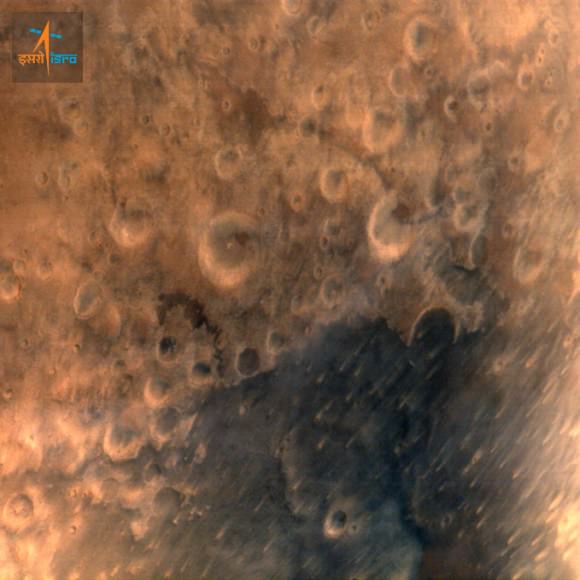India’s maiden interplanetary voyager, the Mars Orbiter Mission (MOM) has transmitted a breathtaking new image eyeing the limb of Mars and its atmosphere against the blackness of space.
The beautiful Martian image is only MOM’s second since successfully braking into orbit during the ‘history creating’ insertion maneuver days ago on Sept. 23/24.
The MOM orbiter was designed and developed by the Indian Space Research Organization (ISRO), India’s space agency, which released the image on Sept 25, about a day after MOM arrived.
The limb image was taken using MOM’s Mars Color Camera (MCC) from an altitude of 8449 kilometers and shows more of an ‘Orange Planet’ rather than a ‘Red Planet.’
“A shot of Martian atmosphere. I’m getting better at it. No pressure,” tweeted ISRO at MOM’s newly established twitter account after entering orbit.
The image has a spatial resolution of 439 meters and is centered around Lat: 20.01N and Lon:31.54E.
MOM’s goal is to study Mars atmosphere , surface environments, morphology, and mineralogy with a 15 kg (33 lb) suite of five indigenously built science instruments. It will also sniff for methane, a potential marker for biological activity.
“The view is nice up here,” ISRO tweeted.
MOM’s first image taken shortly after orbital arrival showed a heavily cratered region of the Red Planet taken by the MCC tri-color camera from a slightly lower altitude of 7300 kilometers with a spatial resolution of 376 meters.

Following MOM’s successful Mars Orbital Insertion (MOI) maneuver, India became the newest member of an elite club of only four entities who have launched probes that successfully investigated Mars – following the Soviet Union, the United States and the European Space Agency (ESA).
Read my complete MOM meets Mars arrival story – here.
MOM is now circling Mars in a highly elliptical orbit whose nearest point to Mars (periapsis) is at 421.7 km and farthest point (apoapsis) at 76,993.6 km. The inclination of orbit with respect to the equatorial plane of Mars is 150 degree, as intended, ISRO reports.
The $73 million mission is expected to last at least six months.
MOM’s success follows closely on the heels of NASA’s MAVEN orbiter which also successfully achieved orbit barely two days earlier on Sept. 21 and could last 10 years or more.
Stay tuned here for Ken’s continuing Earth and planetary science and human spaceflight news.


Thats one breathtaking image. looking forward for more colorful images from MOM.
Some data about the location of the region of this first picture
It is not clear with the available information on which altitude the second picture is taken. MOM follows an strong elliptical orbit around Mars. In Peri Apsis, the altitude of MOM is roughly 365,3 km (like the day’s in a year) above the Mars surface, In Apo-apsis the distance in some 8000 km caused by the elliptical orbit of the satellite.
The first picture is clearly a shot on high altitude but i wonder if the altitude of 7300 for the dsecond picture is correct.
The location of the center of this second picture is on Google Mars positioned on coordinates 1° 0’27.94″Z 68°34’5.77″O. On Google Mars you must be on an altitude around 700 – 800 km to see the whole region visible on this released picture of part of the surface of Mars. The perspective in this picture indicates the satellite was more likely 730 km above the surface, not 7300km.
It is possible that the camera of MOM has a very narrow angle. Anyhow, great picture. I think Arthur Clark will be very proud on the nation he learned astronomy.
In the USA one on four people still think that the Sun rotates around the earth. An equal amount of people in the USA even rejects the idea that some of their greatest heroes went to the moon.
Meanwhile, NASA prepares to go to Mars by 2030 and everybody uses satellite connection to look to soap series and how to lose weight.
Hopefully we will get more pictures on higher resolution if possible and in true color. I hope MOM will soon find the sources of methane on Mars, basically life forms in water. India found water on the moon first.
Hopefully MOM will be first to find specific locations on Mars where prana, life flourishes. If this is the case, wouldn’t it be better that the first human mission to Mars would be a mission sponsored by the world and not by one country.
Because who put’s the flag there first, more or less owns the planet.